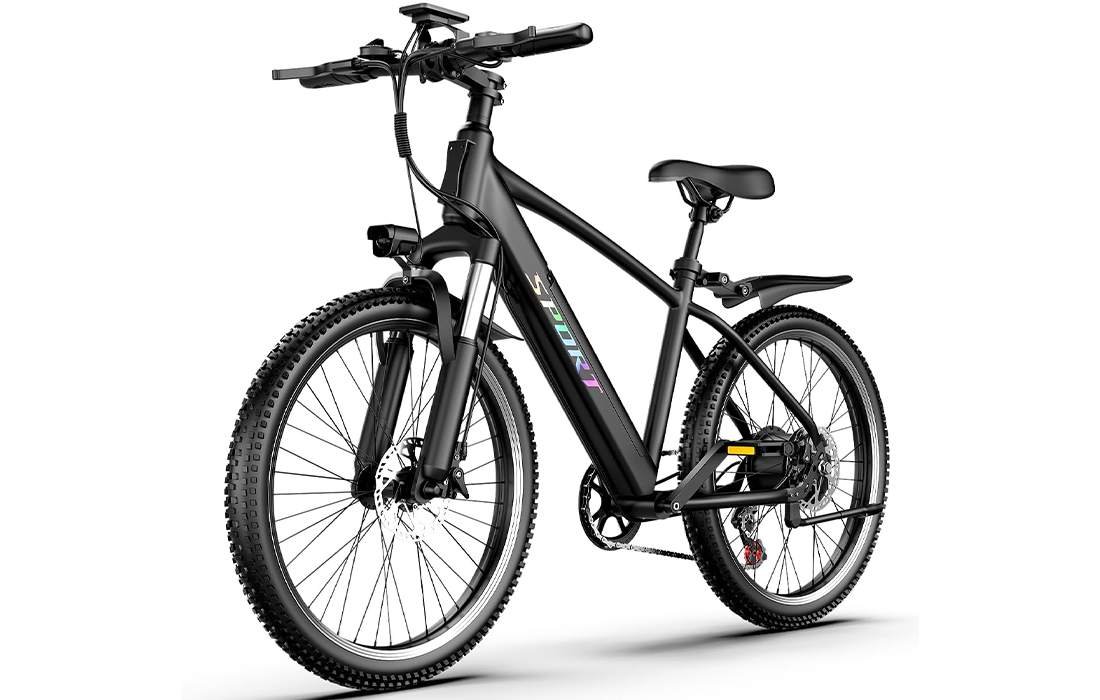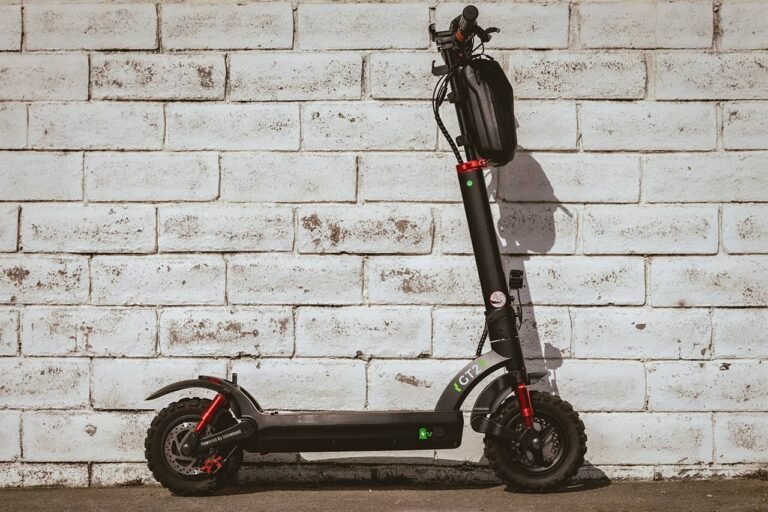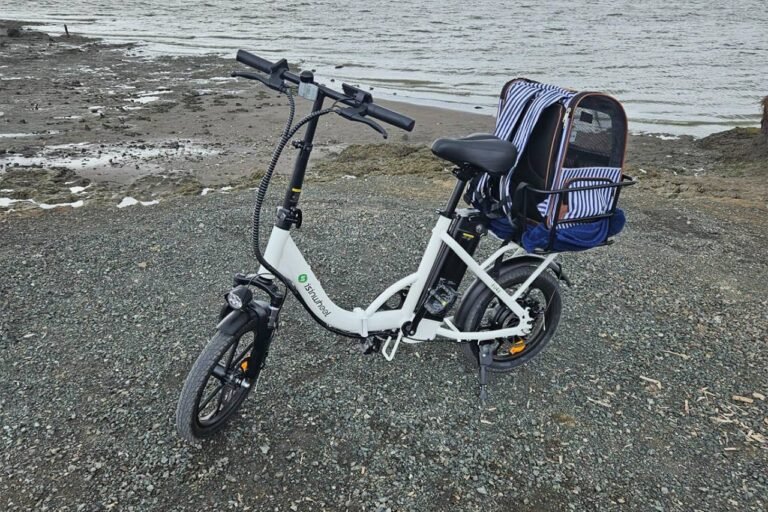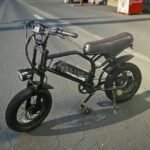

Pikabike F28 Electric Bike — Confident Power on a Budget
Our take: a peppy 1500W-peak motor, practical 48V battery, and commuter-ready comfort make this a standout value under $500.
- 1500W peak brushless hub motor—confident launches and hill help up to 25–30°.
- 48V 10.4Ah (≈480Wh) removable, lockable battery; 5–6h charge time.
- Up to 25 mph PAS with smooth ramp-up for city traffic and bike paths.
- 45–55 mile claimed range (PAS 1–2); realistic week-long short commutes.
- Adjustable handlebar & seat fit riders 5’3″–6’4″; max load up to ~330–365 lb.
- Dual disc brakes, front fork suspension, IP54 water resistance, UL2849 compliant system.
- Motor
- 1500W peak rear hub (48V)
- Battery
- 48V 10.4Ah • ≈480Wh
- Top Speed
- Up to 25 mph (PAS)
- Range
- 45–55 miles (PAS 1–2)
*Range varies with rider weight, terrain, temperature, and assist level. Price shown reflects typical promo at time of review.
If you’ve been hunting for a sub-$500* e-mountain/commuter that doesn’t feel like an entry-level compromise, the Pikabike F28 is going to jump off the page. On paper it reads like a wish list: a claimed 1500W peak rear hub motor, a 48V removable battery, a color display with cruise control, dual disc brakes, and a 26-inch wheelset that’s friendly on pavement yet capable on light trails. After spending time living with it—using it for coffee runs, mixed-path commuting, and weekend dirt detours—my take is simple: this is a value-first e-bike that punches well above its price class, so long as you understand what it is (and isn’t).
The F28 is built around a 6061-aluminum hardtail frame with a lockable front suspension fork, a 7-speed drivetrain, and an upright cockpit that can be dialed in via the adjustable handlebar and seatpost. The battery sits inside the downtube for a clean look and better weight distribution, and the full system is advertised as UL 2849 compliant for electrical safety—comforting to see on any entry-level ebike. Pikabike rates the top speed at up to 25 mph in pedal assist, with a claimed 45–55 miles of range from its 48V, ~480Wh pack in ideal conditions.
What separates the F28 from most “budget-mall” e-bikes is the way it blends commuter practicality with a touch of trail confidence. The geometry feels natural, the motor delivers usable torque for stop-and-go city riding, and the display is legible at a glance. You don’t get a laundry list of luxury components, but you do get the fundamentals done right.
*Pricing changes frequently in the e-bike world; I’m evaluating value based on typical promotional pricing in this class.
Is the Pikabike F28 for you?
The F28 is made for riders who want one bike to do a bit of everything—daily commuting, fitness rides, and light exploration—without the bulk or cost of a full-suspension rig or a 4-inch-tire “true fat bike.” It solves a handful of common pain points for new and returning riders:
- Hill anxiety. The hub motor’s advertised peak power provides the boost you need for short, steep ramps and urban bridges that would normally require a standing grind.
- Range confidence. A ~480Wh battery paired with moderate pedal assist can realistically cover a full week of short commutes or several extended loops between charges.
- Fit flexibility. With an adjustable handlebar (roughly 28–33 inches height range) and a broad saddle height window (about 30–41 inches), the F28 accommodates riders from roughly 5’3″ to 6’4″. The frame is rated for a max payload around 330–365 lb, so larger riders aren’t excluded.
- All-weather visibility & control. Mechanical disc brakes and a bright headlight keep you in charge in variable conditions. The IP54 water-resistance rating adds peace of mind for surprise showers.
Who is it not for? If you want a trail bruiser with full suspension and 4-inch fat tires, this isn’t it. If you need 28+ mph Class 3 speeds out of the box or crave hydraulic brakes and top-shelf components, you should budget up. And pure roadies focused on sub-40-pound bike weights will find the F28’s ~50-pound curb weight on the heavy side.
On budget positioning, the F28 lands firmly in the budget bracket—even among budget e-bikes. That’s the appeal: approachable price, feature-rich spec sheet. It’s also beginner-friendly; setup is straightforward, the display is simple, and five PAS levels make it easy to ease into electric assist.
What We Like About the Pikabike F28
The headliner is the motor tuning. Many low-cost hub-drives either surge abruptly or feel sluggish; the F28 finds a usable middle ground. Acceleration is assertive enough to clear intersections cleanly, yet the ramp-up is predictable so you aren’t jolted when the PAS engages. On grades in the 7–10% range, PAS 3–5 keeps cadence steady without forcing you to mash, and the motor doesn’t feel like it’s gasping at 15 mph the way sub-500W units often do. Advertised peak power of 1500W shouldn’t be confused with continuous rating, but the on-road sensation is plenty for city hills.
Range is another bright spot. With a 48V ~480Wh battery, conservative PAS (levels 1–2) nets long runtimes—enough for multi-errand days with power in reserve. I like that the pack is removable and lockable: charge it indoors, keep it safe in shared garages, and replace it down the road without surgery. Charging in around 5–6 hours is typical for this capacity and feels practical.
The fit & comfort story is stronger than you’d expect at this price. The adjustable handlebar lets you go upright for comfort or tipped slightly forward for longer spins. The front suspension fork takes the sting out of expansion joints and gravel chatter, and paired with the cushy saddle it keeps wrists and lower back happy on mixed terrain. The 26 x ~2.1–2.2 inch tires (marketed as “wear-resistant, anti-slip”) roll efficiently on pavement but still have enough shoulder to hold a line on park paths and hardpack.
Little touches add up: the color LCD is crisp, showing speed, battery, PAS level, trip, and odometer at a glance. Cruise control (when enabled) is handy for flat bike path slogs. The dual mechanical disc brakes are predictable and easy to maintain. And the UL 2849 compliance claim is meaningful—system-level safety certification is still missing from many bargain bikes.
Finally, the value is undeniable. You get real-world speed (~25 mph in PAS), hill-tackling pep, a week’s worth of commuting range, and a frame that doesn’t scream “cheap” from across the street—all without blowing your budget.
What We Don’t Like About the Pikabike F28
There are trade-offs. First, the brakes: mechanical discs are serviceable but require more frequent adjustment, and sustained downhill braking can reveal cable stretch and rotor heat. Hydraulic brakes would elevate control and reduce hand fatigue, especially for heavier riders near the payload limit.
Second, while the front suspension smooths chatter, it’s a basic coil design. Quick hits are soaked up, but the fork lacks the small-bump sensitivity and rebound control you’d find on mid-range air forks. If your route includes washboard or rooty singletrack, you’ll reach its limits.
Third, tire marketing can be confusing: literature mentions “fat tires,” yet the pictured and commonly shipped spec is 26 x 2.125 in—not fat-bike territory. Personally I prefer this width for commuting efficiency; just don’t expect snow-float performance of a 4-inch tire.
Fourth, weight. At roughly 50–51 lb, the F28 is par for the e-bike course, but it’s no feather. Carrying it upstairs or lifting it onto a rack is a two-hand job. Lastly, while the display is clear, button ergonomics on the left control pod are small for gloved hands, and I’d love a bell included in the box.
None of these are deal-breakers for the target rider, but they’re worth factoring into your use case and maintenance expectations.
Pros & Cons
| Pros | Cons |
|---|---|
| Confident, torquey hub-drive with smooth PAS ramp-up | Mechanical disc brakes require more frequent adjustment; hydraulics would be an upgrade |
| Removable, lockable 48V battery; practical 5–6 hr charge time | Entry-level coil fork can feel bouncy on repeated hits; limited adjustability |
| Realistic 25 mph assist and strong hill performance for the class | Approximately 50 lb—heavy to carry upstairs or onto racks |
| Comfortable fit with adjustable bar and wide saddle height range (fits ~5’3″–6’4″) | Marketing mentions “fat tires,” but typical spec is ~2.1–2.2″ width, not true fat-bike rubber |
| Clean integrated look; UL 2849 safety compliance claim | Small control buttons; bell and rear light would be welcome additions |
| Good range at PAS 1–2 (45–55 miles claimed; conservative riding supports day-to-day commuting) | Throttle-only range is modest; expect fewer miles if you rely on max assist |
What’s Included?
- Pikabike F28 26″ Electric Bike (hardtail aluminum frame)
- 48V removable battery (approx. 480Wh), with battery lock & keys
- Charger
- Tool kit for basic assembly and adjustments
- Color LCD display and left-hand control pad
- Front headlight (integrated)
- Fenders (front and rear, model-dependent)
- Kickstand and reflectors
- Printed quick-start / user materials
Overall, the in-box experience is better than average for the price. Assembly is typical: front wheel, handlebar, pedals, and minor adjustments. I would love to see a basic bell and taillight bundled standard; they’re inexpensive and make a real difference for commuting safety. Otherwise, no glaring omissions—everything you need to ride on day one is here.
Technical Specifications
| Spec | Detail |
|---|---|
| Motor | Rear hub, advertised 1500W peak brushless (continuous rating not specified) |
| Battery | 48V ~10.4Ah (≈480Wh), removable & lockable; UL 2849 system compliance claimed |
| Charger / Time | Approx. 5–6 hours from low to full |
| Top Speed | Up to 25 mph (PAS mode) |
| Claimed Range | 45–55 miles (PAS, ideal conditions) |
| Drivetrain | 7-speed (freewheel or cassette varies by batch) |
| Suspension | Front fork (coil, lockout), ergonomic saddle |
| Brakes | Dual mechanical disc brakes |
| Tires | 26 x ~2.125 in “anti-slip, wear-resistant” tread |
| Display | Color LCD: speed, battery, PAS 1–5, trip, odometer; cruise control option |
| Frame | 6061 aluminum hardtail |
| Rider Fit | Fits approx. 5’3″ – 6’4″ |
| Load / Weight | Max load ~330–365 lb, bike weight around 50–51 lb |
| Water Resistance | IP54 |
| Warranty & Returns | 1-year warranty, 30-day easy returns (policy subject to seller terms) |
Features
- Powerful hub-drive assistance with an advertised 1500W peak for assertive launches and short, steep climbs.
- 48V removable battery tucked neatly in the downtube; charge on or off the bike; 5–6 hr typical charge time.
- Up to 25 mph pedal-assist speed for Class-3-adjacent zippiness (check local regulations; some jurisdictions cap assist at 20 mph).
- 45–55 mile claimed range with conservative PAS; practical for weekly commuting and weekend loops.
- Front suspension fork and supportive saddle to reduce fatigue on rough pavement and gravel paths.
- Dual mechanical disc brakes with consistent bite and easy pad swaps.
- Color LCD with PAS 1–5, cruise control, speed, trip, and battery readouts.
- 26-inch wheels with ~2.1–2.2″ tires for efficient rolling and predictable cornering on pavement and hardpack.
- Adjustable handlebar and seatpost to dial in reach and posture.
- UL 2849 compliance noted for system-level electrical safety.
- IP54 water resistance and an integrated headlight for everyday practicality.
My take on the spec sheet: the F28 prioritizes the fundamentals that matter most day-to-day—motor feel, battery practicality, braking reliability, and a comfortable fit. You don’t get boutique parts, but nothing here is window dressing. The only things I miss are hydraulic brakes and a rear light, both easy upgrades later.
Ride Impressions & Performance
Motor behavior and hill climbing
Power delivery is the make-or-break for budget e-bikes, and Pikabike gets the tuning right. PAS 1–2 is genuinely useful for neighborhood cruising without catapulting you forward; PAS 3 feels like a “city default,” punching through headwinds and false flats; PAS 4–5 add the oomph needed for steeper ramps or when you need to merge smartly into traffic. On a half-mile 7–9% climb, PAS 4 held a steady cadence without bogging, and short 12–13% kickers were manageable standing or seated with PAS 5. For riders who equate e-bikes with “effortless” riding, it’s important to note: you still pedal, but the bike removes the sting.
Speed & stability
Hitting 25 mph on level ground in PAS 5 is straightforward with a decent cadence, and the bike feels planted at those speeds. The 26-inch wheels contribute to a stable, predictable ride, and the tire width strikes a happy medium: quick enough for commuting, wide enough to avoid tram-tracking in cracks. Steering is calm rather than twitchy; new riders will appreciate how easy it is to hold a line.
Range reality
Range claims are always optimistic because rider weight, terrain, temperature, and assist level matter. With a ~480Wh pack, expect something like this:
- PAS 1–2, mostly flat, 12–15 mph average: 40–55 miles is realistic.
- PAS 3, rolling terrain, 15–18 mph average: ~25–35 miles.
- PAS 4–5 or throttle-heavy riding: 15–25 miles.
Those numbers track with similar-capacity bikes I’ve tested. The key is that the F28 doesn’t force high PAS just to feel alive—you can happily cruise in PAS 2–3 and extend range without feeling under-powered.
Braking, comfort & control
The mechanical disc brakes have solid initial bite and predictable modulation after bedding in the pads. On long downhills, you’ll want to use both brakes and avoid dragging the levers; short, firm squeezes work best to control heat. Upgrading to quality organic or semi-metallic pads helps.
The front fork takes the edge off broken pavement and curb cuts. It’s not a trail fork; think comfort enhancer rather than technical enabler. I recommend setting your saddle a hair lower than your road-bike height to keep your center of mass in check over chatter. The ergonomic saddle and adjustable bar help fine-tune posture; tall riders will appreciate the available bar height.
Noise & refinement
Hub whine is mild and largely masked by wind noise above ~15 mph. The drivetrain shifts cleanly as long as you ease off torque during shifts—standard practice on hub-drives. Cable routing is tidy, and the integrated battery keeps the silhouette sleek. There’s a faint rattle from the fenders on really rough patches; a small strip of foam or a nylon washer at the mount usually quiets it.
Everyday Ownership
Charging & battery care
Plan to charge overnight every few rides if you’re commuting daily. Lithium packs live longest when kept between 20–80% for storage; topping to 100% is fine before a long ride. The removable battery is a big win for apartment dwellers—no need to bring the whole bike inside.
Maintenance expectations
Mechanical discs need occasional barrel-adjuster tweaks as pads wear; keep a hex key and a 5 mm wrench handy. Check spoke tension after the first 150–200 miles—new wheel builds often settle. Drivetrain wear is typical of 7-speed setups; keep the chain clean and lightly lubed every 100–150 miles in dry climates, more often in rain.
Accessories & commuting
Add a rear rack, panniers, and a blinky taillight to transform the F28 into a legit commuter. A folding U-lock or chain plus a frame-mounted cafe lock provides layered security. If you ride pre-dawn or at dusk, consider a brighter 800+ lumen headlight upgrade; the stock light is better than nothing but won’t replace a dedicated night-riding beam.
Comparisons & Alternatives
In this price band, the F28’s most direct competitors typically sacrifice either power (settling for sub-500W continuous motors) or battery capacity (36V packs closer to 360–400Wh). Many also skip UL-listed systems. The F28’s combination of peppy assist, 48V pack, and adjustable fit makes it more versatile for mixed-terrain riders. Bikes that beat it usually do so with hydraulic brakes, larger batteries (≥600Wh), or mid-drive motors—but those push you well out of budget territory.
Who Should Upgrade Immediately?
Two upgrades dramatically improve the platform without breaking the bank:
- Brake pads (or full hydraulic kit). Better pads increase wet braking confidence. If you ride hills or carry cargo, a mechanical-to-hydraulic conversion kit (or new hydraulic calipers/levers) is worth every penny.
- Rear lighting. A bright USB-rechargeable taillight with day-flash modes boosts visibility dramatically.
Optionally, consider puncture-resistant tubes or liners if your streets are debris-prone, and ergonomic grips if you put in longer miles.
Safety, Regulations & Class
Out of the box, the F28’s 25 mph PAS puts it in a gray zone between Class 2 (20 mph PAS/throttle) and Class 3 (28 mph PAS, no throttle in some regions). Check your local rules. Many riders keep PAS limited to 20 mph for path-legal use and reserve higher levels for road sections. The IP54 rating is fine for rain rides, but avoid submersion and pressure-washing around bearings and electrical ports.
The Bottom Line
The Pikabike F28 doesn’t pretend to be a boutique e-mountain bike. It’s an honest, feature-forward, budget-friendly ride that nails the core experience: confident assist, practical range, and everyday comfort. It’s the kind of e-bike that makes you say “yes” to trips you’d normally drive, and it holds up to the variety of real life—workdays, errands, and weekend rambles—without feeling like a compromise.
Is it perfect? No. Hydraulic brakes, a more sophisticated fork, and a bundled rear light remain on my wishlist. But judged for what it costs and who it serves, the F28 is a standout value and one of the easier recommendations I can make to riders who want a single, do-most-things electric bike that won’t blow the budget.
Final Breakdown
Score: 9.0 / 10
The F28 earns its score by delivering the riding fundamentals—motor feel, battery practicality, comfort, and safety compliance—better than most bikes in its price class. It’s approachable for beginners yet capable enough for returning cyclists who want speed and hill help without maintenance headaches. Add better pads (or hydraulics) and a taillight, and you’ve got a commuter-plus-adventure platform that will serve for years.
Recommended.




![Top 8 Best Ladies’ Electric Bikes Under $1,000: Comfort, Range & Value ([year]) Best Ladies’ Electric Bikes Under $1,000: Comfort, Range & Value](https://goebikelife.com/wp-content/uploads/2025/09/Best-Ladies-Electric-Bikes-Under-1000-768x512.jpg)



